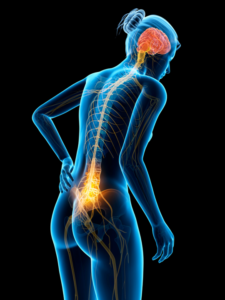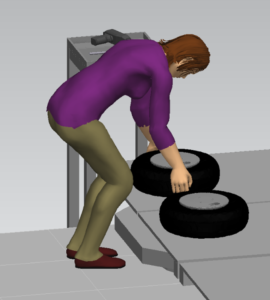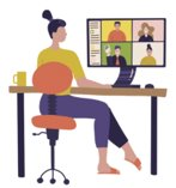Tips for pain free summer gardening:
- Using a stool can help reduce the pain of squatting or kneeling
- Bend with your knees and invest in a good wheelbarrow
- Key tools organized and within reach
- Keep your thumbs up! Make sure your wrists aren’t doing heavy lifting when using garden tools
- Hydrate and enjoy yourself
To see more tips and references, read the full article below.
—
After a ruthless winter, summer weather had many people anxious to get back outdoors to enjoy some leisurely activities, such as gardening. Many take tremendous pride in the appearance of their yard and garden, but often feel the physical impact of this activity. Which often leaves them wondering, “is the pain worth the pride”?
Often bad habits contribute to the pain that is experienced while gardening. By exploring alternative methods to these behaviors and correcting them, you can experience the joy of gardening again!
Habit 1: Bending/Stooping
Multiple aspects of gardening involve working at ground level, which requires individuals to bend to reach the job. Bending from the waist and craning the neck is not an appropriate way to reach the gardening task.
It is important to bend knees and squat, which activates your leg and buttock muscles; large, strong, and supportive muscles. This is a healthy alternative to bending from the waist and placing large amounts of strain on your back muscles.
If you plan on doing a large amount of work from ground level and find squatting to be difficult you could also use a garden stool to sit on or a cushion to kneel on.
Habit 2: Lifting
Moving dirt or carrying objects is a frequent task involved in gardening. However, similar to bending, back injuries are common if bad habits are practiced. It is important to always use two hands to lift an object. If you are lifting an object with one hand, use the other to brace yourself.
It is also important to keep the object close to your body (center of mass), the further the horizontal distance between the object and your body the greater the compression force on your back. Contracting your abdominal muscles and avoiding twisting or sudden movements further protects your back from possible injury. If possible, eliminate the lift by rolling the object to you using a wheelbarrow.
Habit 3: Reaching
Constantly reaching above your shoulders for overhead work can cause significant discomfort in your shoulders and neck. In addition, reaching further than 20” from your body is not preferred and can cause some irritation, especially if you are repeatedly grabbing or exchanging tools.
If you are working overhead, limit the time to about five minutes and take a break. Use a step ladder if the ground allows this to be used safely to eliminate having to work overhead. Keep your gardening tools near your work area, keep them organized in a container or work belt so you do not have to reach around trying to grasp them for each task.
Habit 4: Poor Posture
Having poor posture, especially in conjunction with repetitive motions can lead to nerve and tendon irritation and fatigued muscles. Since we have already discussed working overhead and bending, let’s focus on the wrist.
The optimal position for the wrist is the neutral position. Avoid excessive manipulation of the wrist up, down, and sideways, especially against a force, this will aggravate the nerves and tendons and lead to inflammation. Instead, use tools that have a bent/curved handle and avoid working with your thumbs facing the ground.
Habit 5: Unfit Tools
Using the right tools for gardening is helpful in reducing discomfort and risk for injury. Some tools have built in grooves for your fingers; however, this does not enhance the tool. Due to the variation in individual’s hand sizes, people with small fingers will end up squeezing the tool tighter to maintain their grasp, while those with larger hands will end up overlapping contacting the sharp edge of the groove or spilling into the next groove. Although subtle, this type of contact stress can create injuries.
It is important to be aware of how you are grasping your tools, whether it refers to the duration, intensity, or type of grip. Holding tools for a short time with light tension using a power grip will yield the lowest risk for injury.
Remember it is summer, so it is bound to be hot. Make sure to drink plenty of water and rotate the type of work you are doing every 15 minutes. This prevents fatigue and allows different muscle groups to recover!








 Why Sandalwood?
Why Sandalwood?


 We are a one-stop-shop for launching job rotation for any employer from conception to implementation. Our experts tailor our services to meet the needs of our customers by collaborating with them throughout the entire process. We do not offer cookie cutter solutions for job rotation because the needs of employers vary significantly.
We are a one-stop-shop for launching job rotation for any employer from conception to implementation. Our experts tailor our services to meet the needs of our customers by collaborating with them throughout the entire process. We do not offer cookie cutter solutions for job rotation because the needs of employers vary significantly. Why Sandalwood?
Why Sandalwood?



 Sandalwood is pleased to offer solutions above and beyond the traditional ergonomic assessments. With an in-depth knowledge of various digital human modelling software suites, integration and adoption to your health and safety programs has never been easier. Sandalwood is experienced in ergonomic program design as well as industry leaders in digital human modelling services. We have a diverse team that is able the leverage the results from the digital human model to provide in depth risk assessments of future designs and current state. Sandalwood is also able to pair these assessments with expertise and provide guidance on the best solution for you. Sandalwood is also on the forefront of emerging technologies and able to integrate Motion capture, Wearables, and extended or virtual reality into your ergonomic program.
Sandalwood is pleased to offer solutions above and beyond the traditional ergonomic assessments. With an in-depth knowledge of various digital human modelling software suites, integration and adoption to your health and safety programs has never been easier. Sandalwood is experienced in ergonomic program design as well as industry leaders in digital human modelling services. We have a diverse team that is able the leverage the results from the digital human model to provide in depth risk assessments of future designs and current state. Sandalwood is also able to pair these assessments with expertise and provide guidance on the best solution for you. Sandalwood is also on the forefront of emerging technologies and able to integrate Motion capture, Wearables, and extended or virtual reality into your ergonomic program.



